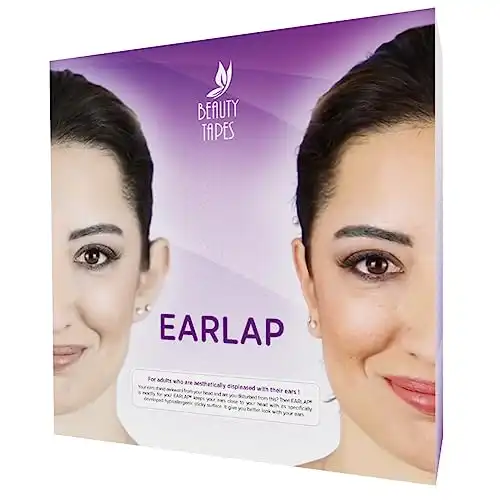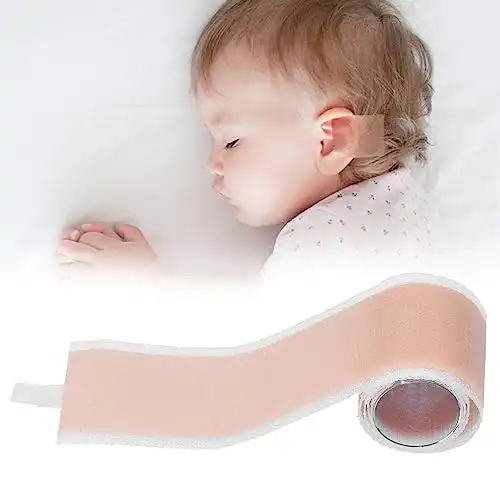How to fix protruding ears without surgery, 11 tips that actually work

How to correct protruding ears at home without ear surgery? Having big ears causes people a great deal of self-consciousness about their looks. Previously it was almost impossible to correct protruding ears without surgery, but now it is possible.
After careful research to find out what works, here's what I know:
To correct stick-out ears, you should start by taking care to support them at night instead of deforming the cartilage or using external elements such as glues or silicones. For a total solution for big ears without an operating room, there is the Earfold implant, which folds the ear cartilage.
However, it is no longer necessary surgical correction nowadays. Instead, you can correct ear deformities at home. Below we will present how protruding ears affect people, a series of non-surgical options that you can practice at home to forget about protruding ears and hide them, as well as a series of tips that will help you hide them.
What are protruding ears?
This aesthetic problem is also known as elf ears, dumbo ears, prominent ears, bat ears. This aesthetic issue is due to the lack of one of the ear folds called antihelix, producing a considerable depth of the ear shell.
The protruding ear is because the upper and side parts are more than 2 centimeters away from the head. That does not affect the hearing in any way, but it affects the person's self-esteem who suffers it. In some cases, the protruding ear manages to hide or look more discreet as the child grows.
It is a hereditary congenital deformity estimated to affect 5% of the population. The most common defect of the protruding ear is the lack or insufficient development of one of its folds called the antihelix.
Many people's ears with prominent features are directly related to their family history.
This disease causes people who present it self-consciousness, especially in children, causing difficulties to integrate. In most cases, this problem occurs in both atria.
You may be interested in "How to get hollow cheeks, 11 Tips"
How does having protruding ears affect people?
Children are the most affected by this physical problem. Young children are more vulnerable to ridicule about this defect called protruding ears.
Continuous teasing or insults have psychological consequences on the child, causing them to lose their self-esteem immediately. Therefore, most parents decide to submit their children to a surgical operation called Otoplasty to deal with this problem.
Out of 10 people who get this plastic surgery to fix this deformity, 7 are minors, and 60% are male interventions. Although this case occurs in both sexes, girls are more concealed with long hair.
This problem also brings many insecurities for being the target of mockery, jokes, and comments related to their ears in adults.
Almost half of the adults with this condition manage to camouflage the protruding ears by combing their hair differently, avoiding wearing hats, or not placing profile pictures highlighting the ears.
How to fix ears that stick out without surgery?

Sleep in the correct position
If your ears stick out excessively, the first thing is to correct the problem as soon as possible as the baby's ears because the cartilage is not formed and is easier to fix. To achieve this, you must be aware that babies sleep with the ear in the correct position on the pillow, preventing them from bending outward.
Use a transparent silicone prosthesis.
It is an aesthetic corrector that consists of a transparent and almost invisible silicone prosthesis. It is placed on the top of the ear and stuck through adhesives, from the head to the auricle. This prosthesis has a hypoallergenic adhesive so that the silicone prosthesis is not detached.
It is easy to use, and its invisible effect acts as a prevention method if used at an early age since it maintains the ear's position correctly. However, if the patient is less than seven years old, this treatment should permanently correct the ear's malformation. The ideal time to achieve good results would be after six months.
This technique has no side effects; in the case where the age or the formation of the ear cartilage cannot correct the malformation because the procedure can be used as a delay of surgical intervention until an age where doctors recommend doing the surgery.
Glue
People use this bond to stick beards, wigs, prostheses, and others, to adhere to the ears.
How to use it:
- You must place a few drops of the product with a brush in the part of the ear you want to glue.
- Then you will have to wait a few minutes for the glue to set.
- Then touching with your finger and seeing that it is sticking the ear as firmly as you can.
- Press for a few minutes until the glue dries entirely so that the ears will remain stuck all night.
How to remove the glue:
For this, you must use a particular product called glue remover. Although you can do it using wet cotton with plenty of alcohol, you put it on the ear and rub it carefully to remove the glue gradually.
Otostick
It is a cosmetic corrector used for protruding ears, indicated for all three and older children. There is also the Baby Otostick, which is meant for babies from 3 months onwards.
With this instrument, we try to correct the deviation of the cartilages. To obtain it will have to be used for at least six months, which is more helpful while more minor is the child.
The Otostick is a small transparent piece of silicone, which is placed behind the ears and attached to the head’s skin due to the unique hypoallergenic adhesive that is incorporated to remove it is pulled a little from the ear. It keeps the ears in a proper position, without being noticed.
The adhesive lasts approximately four days without a problem, although you can wear it for up to two or three weeks. You can use it without contraindications in swimming pools, beaches, sports, or washing your hair.
Splints
Some of them serve to shape the ear. Sleep with your ears adequately positioned on the pillow, and we don't allow them to fold out. Some people have more malleable cartilage of the ear, and by achieving a good posture when they sleep, they can change its form.
DisRas
It is a system that does not produce pain, and you can find it in pharmacies without the need to present a prescription. It is a transparent silicone prosthesis placed just behind the ear and attached to the head with hypoallergenic adhesives producing an immediate effect. They are two sheets that stick, and their size does not pass to a lens. It can be used by any person at any age, starting at three months.
Stickers
They help you hide your protruding ears, and we can only use them on special occasions. However, they come off after 1 or 2 days, they can become irritating to the skin, and their effects are not permanent.
Plasters
It is a traditional method, easy to use and economical, used by grandmothers, where they use the tape to keep the ears in the proper position you want using glue.
Double-sided adhesive tape
The first thing is to get an excellent double-sided transparent tape or glue used for skin and stick decorations on the skin when it is carnival or Halloween. Then, to place it, you must follow the following steps:
- Next, cut the adhesive tape into several pieces.
- Place it just behind your ear, following the ear’s curve from top to bottom. That is to make it easier for you to place.
- Then press on the ear, being careful. We do this to stick the tape well.
- To ensure that they are well attached, set the amount you think is convenient.
- When you finish using the tape, wash it well behind the ear to remove the remaining glue.
Earfold
I couldn't finish this section on correcting protruding ears at home without mentioning the Earfold. I know we can not do it at home, but it is such a quick and non-invasive procedure (minor surgery) to fix every ear deformity that I must give you this information.
The Earfold is a new technique to correct that aesthetic deformity called protruding or prominent ears. A nickel-titanium tab is inserted with an external device to modify the auricular cartilage fold to place the ear in the desired position.
First, They place an external implant to simulate the final result of the Earfold before operating.
By placing one of these devices in the patient's ear, we will know if they can use the Earfold in that patient. Besides, the patient will see to what extent their ear's deformity can be corrected.
The device is placed just under the perichondrium and skin. Later on, this plate, made of a nickel-titanium alloy, will be perfectly integrated by the patient,
Until now, the only option we had for correcting protruding ears was to use the surgical technique known as Otoplasty. Since it is a surgical technique, logically, it needs an operating room and an anesthetic procedure, either local or sedation. Sometimes even, in more sensitive patients, with general anesthesia.
More about earfold
Currently, with the Earfold, provided we can place it in individual patients, we will have a less invasive alternative to this Otoplasty.
Doctors say this technique has many advantages when compared to Otoplasty:
- First, it is an operation that lasts about 20 minutes, which is incredible if we compare it with the Otoplasty that lasts an hour and a half.
- It does not require an operating room. They can perform it in a treatment room in the office.
- They use local anesthesia (no more pain medication.)
- It has no side effects, only if the patient is allergic to any of the anesthetics.
- It requires a minimal incision, which is then closed with one or two stitches.
You may be interested in "How to fix an upturned nose?"
Hairstyles for men:
It is challenging for men to get over protruding ears because they do not have the necessary hair to hide them or have short hair.
For men who have this type of ears, the idea is to cut them in half, being this is the only cut that can disguise them. Besides, it would be best to let the hair grow to cover the ears. With this type of cut, you should leave the hair at the back of the head a little longer to compensate for the ears' effect.
Let your beard grow, divert attention from the protruding ears, and use the lumberjack beard shape. They call it so because it is very long and presents disorders.
Tips and tricks to disguise protruding ears
Use makeup to your advantage
Try to make your makeup look even and focus on highlighting your face's specific areas, such as your cheekbones or nose. Make the contour distract attention from the ears. It would be best to use a dark tone to mark the shape and a lighter style to highlight specific areas of the face, such as the forehead, cheekbones, and nose bridge.
With this, you will achieve an effect of shadow and light that will illuminate your face and not focus attention on the ears.
Use eye-catching glasses
Wear unique accessories such as lenses, as they allow your eyes to focus on them and not on your ears. The style of glasses you should wear is a cat-eye style to draw your eyes' attention and lengthen your face. Also, large-frame glasses, especially sunglasses, will help you hide your protruding ears, so don't wear small lenses.
Wear long earrings

Wear long, thin earrings with hoops or chains to hide the size of your ears.
Give your hair more volume.
Get volume in your hair with thick waves or leave it straight, but never put your hair behind your ears or leave it straight.
Use a degaussed cut
He wears a long, moving haircut, for which he degrades the front of the hair and makes a French fringe. You can find the best 21 haircut ideas with pictures if you love short haircuts.
Wear a high ponytail
Comb your hair with a high ponytail, leaving some tufts in the front. Again, it would be best to wave it slightly to achieve volume in this part of the face.
Wear very flashy clothes
Try to decorate your clothes with an outstanding style or garments that draw attention so that people's eyes focus on these parts and not on the ears.
Let your hair grow
It will be easier to hide your ear if you like long hair. The exciting thing is that the hair covers the ears and gives you volume. You can also braid your hair and wear accessories or earrings.
It would be best to accompany them by a fringe covering the forehead or put a long strand to the side covering the ears and is in harmony with the cut.
If you like your hair short, opt for a haircut that covers your ears, or if it's too short, then have some volume in the middle to hide the attention to your protruding ears.
Cover your ears
Completely cover your ears with various accessories such as headbands, earmuffs, turbans, scarves, hoods, or hats large enough to fit your ears.
How to correct protruding ears in a baby
There are often babies born with bent ears, but pediatricians say that as the child grows, the ears will take their natural shape due to cartilage's growth and thus harden accordingly.
The baby has a congenital malformation called "protruding ears," where the ears' size, shape, and position are not proportional.
We can correct this problem and future ear deformities by preventing the cartilage from bending when lying down. We can also use skin-friendly silicone or adhesive strips can.
Conclusion
Correcting the ears at home without a plastic surgeon and getting ear reconstructive surgery may be possible, but if you see that they don't give you results, you should opt for Otoplasty.
We show you techniques that will help you conceal protruding ears and divert attention from other areas, but they don't have permanent results.
DISCLAIMER: buildyourbody.org does not provide medical advice, examination, or diagnosis.
Medically reviewed and approved by Nataniel Josue M D.



